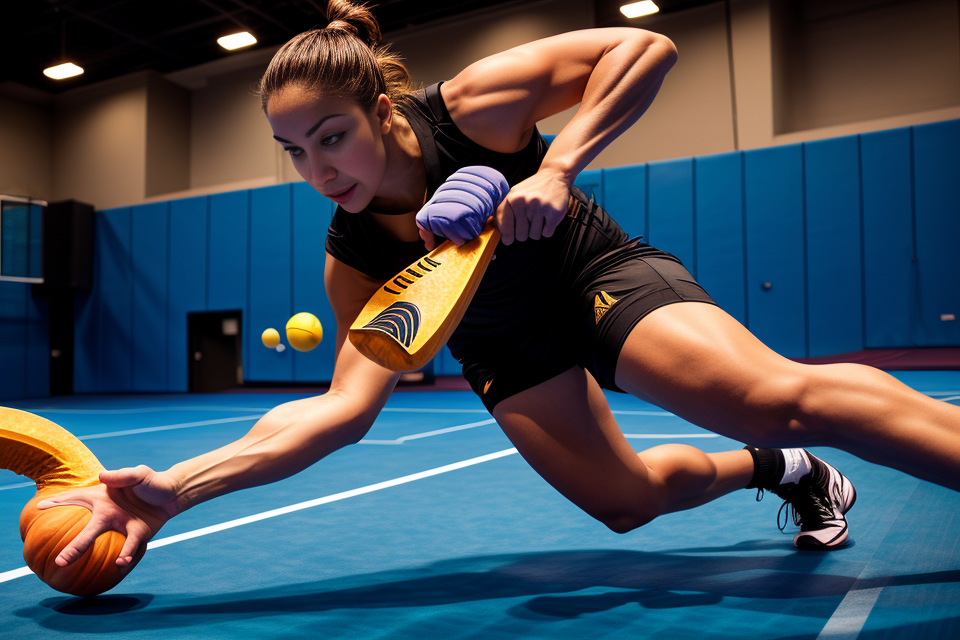Squash is a physically demanding sport that requires speed, agility, and endurance. While it is a great way to stay fit and healthy, it also comes with its fair share of injuries. However, with the right preventative measures, you can minimize your risk of injury and enjoy the game without interruption. In this article, we will explore some tips and techniques to help you prevent common injuries in squash. From warming up properly to using the right equipment, we’ve got you covered. So, let’s get started and keep those injuries at bay!
Understanding Squash Injuries
Common Injuries in Squash
Squash is a physically demanding sport that requires quick movements and changes in direction. As a result, injuries are common among players, and it is important to understand the most common types of injuries that can occur.
Muscle Strains
Muscle strains are one of the most common injuries in squash, and they can occur in any muscle group, including the legs, back, and arms. These injuries typically occur when a muscle is stretched beyond its capacity, and they can range from mild to severe. Symptoms of a muscle strain include pain, swelling, and reduced range of motion.
Tendinitis
Tendinitis is another common injury in squash, and it occurs when the tendons that connect the muscles to the bones become inflamed. This condition is often caused by repetitive motions, such as those involved in squash, and it can cause pain and stiffness in the affected area.
Ligament Sprains
Ligament sprains are also common in squash, and they occur when the ligaments that connect the bones in a joint become stretched or torn. This can happen as a result of sudden changes in direction or landing awkwardly after a jump. Symptoms of a ligament sprain include pain, swelling, and difficulty moving the affected joint.
Overuse Injuries
Overuse injuries are common in squash, particularly among players who train for long periods of time or play multiple matches in a row. These injuries are caused by repetitive motions that place stress on the body, and they can lead to chronic pain and inflammation. Examples of overuse injuries in squash include tennis elbow, golfer’s elbow, and plantar fasciitis.
Eye Injuries
Finally, eye injuries are a potential risk in squash, particularly for players who wear glasses or contact lenses. Squash balls can travel at high speeds, and they can cause serious eye injuries if they hit the eye directly. It is important for players to wear appropriate eye protection, such as sports goggles, to prevent eye injuries.
Causes of Squash Injuries
- Lack of proper warm-up: Squash is a fast-paced sport that requires quick movements and changes in direction. Therefore, it is crucial to warm up before playing to prevent injuries. A proper warm-up should include light cardio exercises, stretching, and dynamic movements to prepare the muscles for the physical demands of the game.
- Poor technique: Using improper techniques while playing squash can lead to injuries. For example, using an incorrect grip on the racket or swinging incorrectly can result in elbow or shoulder injuries. It is important to learn proper techniques from a coach or experienced player to avoid injuries.
- Overexertion: Overexertion is a common cause of injuries in squash. Players may try to make shots that are beyond their abilities, leading to strain on their muscles and joints. It is important to play within one’s limits and avoid pushing oneself too hard to prevent injuries.
- Not allowing enough recovery time: Squash is a physically demanding sport that requires recovery time between games and matches. Not allowing enough recovery time can lead to fatigue and increase the risk of injuries. It is important to take breaks and allow the body to recover before resuming play.
- Insufficient equipment: Using insufficient equipment can also lead to injuries in squash. For example, using a racket that is too heavy or too light can cause wrist or elbow injuries. It is important to use proper equipment that is appropriate for one’s skill level and playing style to prevent injuries.
Prevention Strategies
Warm-up and Stretching
Importance of a Proper Warm-up
Prior to engaging in any physical activity, it is crucial to prepare the body for the demands that will be placed upon it. A proper warm-up serves to increase blood flow to the muscles, raise the core body temperature, and increase the elasticity of the muscles and connective tissues. This preparation helps to prevent injuries by preparing the body for the physical demands of squash and reducing the risk of muscle strain or tear.
Dynamic Stretching Exercises
Dynamic stretching involves movements that gradually increase in intensity and involve active movement of the muscles. Examples of dynamic stretching exercises include leg swings, arm circles, and hip openers. These exercises help to increase flexibility, range of motion, and muscle activation, all of which are important for preventing injuries in squash.
Static Stretching Exercises
Static stretching involves holding a stretch for a period of time to elongate the muscle and increase flexibility. Examples of static stretching exercises include toe touches, hamstring stretches, and calf stretches. These exercises are best performed after a dynamic warm-up and should be held for at least 15-30 seconds to be effective. Static stretching is important for preventing injuries by improving flexibility and reducing the risk of muscle strain or tear.
It is important to note that a proper warm-up should include a combination of both dynamic and static stretching exercises to fully prepare the body for physical activity. Additionally, it is recommended to hold each stretch for at least 15-30 seconds to ensure effectiveness.
Proper Technique
Maintaining correct body position
Proper body positioning is essential in preventing injuries in squash. It helps in reducing the strain on the joints and muscles, which in turn reduces the risk of injury. Players should maintain a balanced and upright posture, with their feet shoulder-width apart, and their knees slightly bent. This position provides better stability and allows for better movement around the court.
Using proper grip and footwork
Using the correct grip on the squash racket is crucial in preventing injuries. A loose grip can lead to wrist injuries, while a tight grip can cause hand and finger strain. Players should hold the racket with their dominant hand at the top of the handle, and their non-dominant hand at the bottom. This grip provides better control and power when hitting the ball.
Proper footwork is also essential in preventing injuries. Players should move around the court with smooth and efficient footwork, using short and quick steps to get into position for shots. Running and jumping should be done with proper form to avoid putting too much strain on the joints.
Avoiding quick or jerky movements
Quick or jerky movements can lead to muscle strains and sprains in squash. Players should avoid sudden changes in direction or movement, and instead, use smooth and controlled movements when moving around the court. This helps in reducing the risk of injury and also improves the player’s overall performance on the court.
Overall, proper technique is essential in preventing injuries in squash. By maintaining correct body position, using proper grip and footwork, and avoiding quick or jerky movements, players can reduce their risk of injury and improve their game.
Equipment and Court Safety
Using appropriate gear is essential to prevent injuries in squash. Eye guards should be worn at all times during play to protect the eyes from any stray balls or debris. Protective shoes with non-marking soles should also be worn to provide better grip on the court surface and to prevent slips and falls.
Ensuring that the court surfaces are well-maintained is also crucial. Courts should be clean and free of any debris or obstructions, and the lighting should be adequate to allow for clear visibility.
Additionally, it is important to adjust the court settings based on your skill level. Beginners should start with a smaller court and softer ball to learn the basics of the game before progressing to a full-sized court and harder ball. Adjusting the height of the ball machine or using a lower net can also help beginners improve their skills.
By taking these equipment and court safety measures, players can significantly reduce their risk of injury while playing squash.
Rest and Recovery
Understanding the Importance of Rest Days
Rest days are essential for both physical and mental recovery. They allow the body to repair and rebuild muscle tissue, reduce muscle soreness, and prevent overtraining injuries. It is recommended to have at least one rest day per week, with a maximum of two consecutive days of training.
Cross-Training and Active Recovery
Cross-training involves incorporating different types of exercise into your routine, such as cardio, strength training, and flexibility exercises. This approach can help prevent overuse injuries and improve overall fitness. Active recovery techniques, such as light jogging or foam rolling, can also help to reduce muscle soreness and improve circulation.
Gradual Increase in Intensity and Duration of Workouts
It is important to gradually increase the intensity and duration of your workouts to avoid injury. Starting with a lower intensity and gradually increasing the intensity over time can help to build up the body’s tolerance for more challenging workouts. Additionally, gradually increasing the duration of workouts can help to prevent fatigue and overuse injuries.
Strength and Conditioning
Strength and conditioning exercises are crucial in preventing common injuries in squash. Here are some specific exercises that can help:
Specific exercises for squash-related injuries
- Foot and ankle strengthening exercises: These exercises can help prevent common injuries such as plantar fasciitis and ankle sprains. Examples include calf raises, heel raises, and single-leg squats.
- Shoulder and upper back strengthening exercises: These exercises can help prevent shoulder injuries and upper back pain. Examples include shoulder presses, rows, and lateral raises.
- Wrist and forearm strengthening exercises: These exercises can help prevent wrist and forearm injuries. Examples include wrist curls, reverse curls, and forearm pronation and supination exercises.
Balancing muscle groups
- Squash involves repetitive movements that can lead to muscle imbalances. To prevent injuries, it’s important to balance the muscles on either side of the body.
- Examples of exercises that can help balance muscle groups include lunges, step-ups, and leg press.
Core strengthening exercises
- A strong core can help prevent lower back pain and improve balance and stability on the court.
- Examples of core strengthening exercises include planks, sit-ups, and Russian twists.
Remember to consult with a fitness professional or a sports medicine specialist before starting any new exercise program.
Mental Preparation
Mental preparation is a crucial aspect of preventing injuries in squash. By building mental toughness and staying focused during games, players can reduce the risk of injuries and perform at their best.
Mind-body connection
The mind-body connection is a fundamental principle in sports psychology. It emphasizes the importance of the mental state in affecting physical performance. In squash, players who have a strong mind-body connection are better able to control their movements, anticipate their opponents’ moves, and respond quickly to changing situations on the court. This mental focus can help prevent injuries by reducing the risk of poor technique or overexertion.
Building mental toughness
Mental toughness is the ability to remain focused and resilient in the face of adversity. In squash, mental toughness can help players overcome setbacks, such as losing a point or making a mistake, and stay focused on the task at hand. Building mental toughness involves developing a positive mindset, visualizing success, and cultivating emotional control. Players can practice visualization techniques, such as imagining successful shots and outcomes, to build mental toughness and reduce the risk of injury.
Staying focused during games
Staying focused during games is essential for preventing injuries in squash. Players who are mentally distracted or lack focus may be more likely to make mistakes or take unnecessary risks, which can increase the risk of injury. To stay focused, players can use visualization techniques, such as imagining successful shots and outcomes, and maintain a positive mindset. Players can also practice mindfulness techniques, such as deep breathing and body awareness, to stay present and focused on the game. By staying focused and mentally prepared, players can reduce the risk of injuries and perform at their best.
FAQs
1. What are the most common injuries in squash?
The most common injuries in squash include muscle strains, tendinitis, and stress fractures. These injuries often occur due to overuse or poor technique, such as incorrect footwork or swinging the racquet with excessive force. It’s important to take steps to prevent these injuries by warming up properly, using proper technique, and allowing adequate recovery time.
2. How can I prevent muscle strains in squash?
To prevent muscle strains in squash, it’s important to warm up properly before playing. This can include dynamic stretches, such as leg swings and arm circles, to increase blood flow and mobility. Additionally, it’s important to use proper technique when hitting the ball, avoiding excessive force or improper movements that can strain muscles. Finally, make sure to stretch and cool down after playing to help prevent muscle soreness and strain.
3. How can I prevent tendinitis in squash?
To prevent tendinitis in squash, it’s important to take breaks between matches and practice sessions to allow for adequate recovery time. This can help reduce inflammation and prevent overuse injuries. Additionally, using proper technique when hitting the ball can help reduce the risk of tendinitis, as excessive force or improper movements can put added stress on tendons. Finally, incorporating strength training exercises that target the muscles and tendons used in squash can help improve overall muscle and tendon health.
4. How can I prevent stress fractures in squash?
To prevent stress fractures in squash, it’s important to take breaks between matches and practice sessions to allow for adequate recovery time. This can help reduce the risk of overuse injuries. Additionally, using proper technique when hitting the ball can help reduce the risk of stress fractures, as excessive force or improper movements can put added stress on bones. Finally, incorporating strength training exercises that target the muscles and bones used in squash can help improve overall bone health and reduce the risk of stress fractures.
5. What are some tips for proper footwork in squash?
Proper footwork is essential in squash, as it helps players move quickly and efficiently around the court. Some tips for proper footwork include keeping the feet shoulder-width apart, using a slight bend in the knees, and maintaining good balance and posture. Additionally, focusing on smooth, efficient movements and avoiding sudden stops or starts can help prevent injuries and improve overall performance. Finally, practicing footwork drills and techniques can help improve footwork over time.










